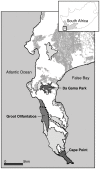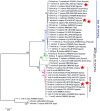Phylogenetic evidence that two distinct Trichuris genotypes infect both humans and non-human primates
- PMID: 22952922
- PMCID: PMC3429462
- DOI: 10.1371/journal.pone.0044187
Phylogenetic evidence that two distinct Trichuris genotypes infect both humans and non-human primates
Abstract
Although there has been extensive debate about whether Trichuris suis and Trichuris trichiura are separate species, only one species of the whipworm T. trichiura has been considered to infect humans and non-human primates. In order to investigate potential cross infection of Trichuris sp. between baboons and humans in the Cape Peninsula, South Africa, we sequenced the ITS1-5.8S-ITS2 region of adult Trichuris sp. worms isolated from five baboons from three different troops, namely the Cape Peninsula troop, Groot Olifantsbos troop and Da Gama Park troop. This region was also sequenced from T. trichiura isolated from a human patient from central Africa (Cameroon) for comparison. By combining this dataset with Genbank records for Trichuris isolated from other humans, non-human primates and pigs from several different countries in Europe, Asia, and Africa, we confirmed the identification of two distinct Trichuris genotypes that infect primates. Trichuris sp. isolated from the Peninsula baboons fell into two distinct clades that were found to also infect human patients from Cameroon, Uganda and Jamaica (named the CP-GOB clade) and China, Thailand, the Czech Republic, and Uganda (named the DG clade), respectively. The divergence of these Trichuris clades is ancient and precedes the diversification of T. suis which clustered closely to the CP-GOB clade. The identification of two distinct Trichuris genotypes infecting both humans and non-human primates is important for the ongoing treatment of Trichuris which is estimated to infect 600 million people worldwide. Currently baboons in the Cape Peninsula, which visit urban areas, provide a constant risk of infection to local communities. A reduction in spatial overlap between humans and baboons is thus an important measure to reduce both cross-transmission and zoonoses of helminthes in Southern Africa.
Conflict of interest statement
Figures



References
-
- Daszak P, Cunningham AA, Hyatt AD (2000) Emerging infectious diseases of wildlife–threats to biodiversity and human health. Science 287: 443–449. - PubMed
Publication types
MeSH terms
Substances
LinkOut - more resources
Full Text Sources
Miscellaneous

